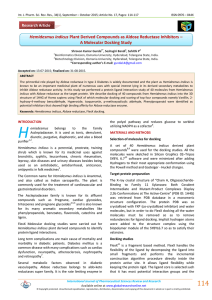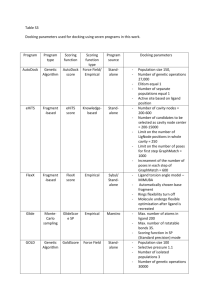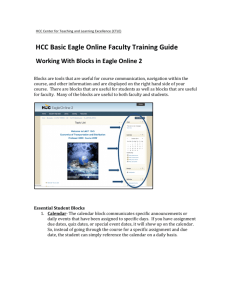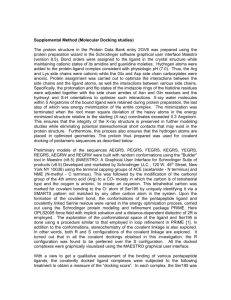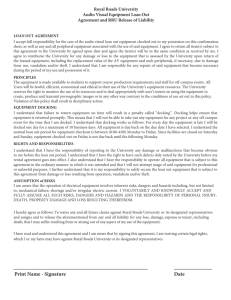Document 13310884
advertisement
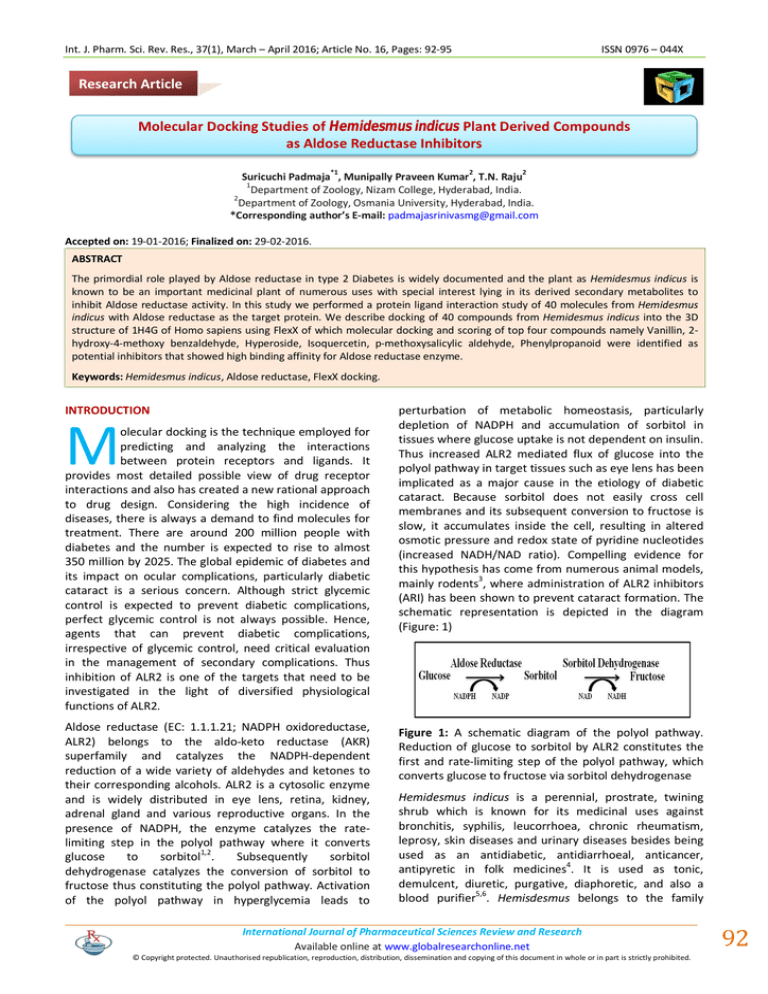
Int. J. Pharm. Sci. Rev. Res., 37(1), March – April 2016; Article No. 16, Pages: 92-95 ISSN 0976 – 044X Research Article Molecular Docking Studies of Hemidesmus indicus Plant Derived Compounds as Aldose Reductase Inhibitors *1 2 2 Suricuchi Padmaja , Munipally Praveen Kumar , T.N. Raju 1 Department of Zoology, Nizam College, Hyderabad, India. 2 Department of Zoology, Osmania University, Hyderabad, India. *Corresponding author’s E-mail: padmajasrinivasmg@gmail.com Accepted on: 19-01-2016; Finalized on: 29-02-2016. ABSTRACT The primordial role played by Aldose reductase in type 2 Diabetes is widely documented and the plant as Hemidesmus indicus is known to be an important medicinal plant of numerous uses with special interest lying in its derived secondary metabolites to inhibit Aldose reductase activity. In this study we performed a protein ligand interaction study of 40 molecules from Hemidesmus indicus with Aldose reductase as the target protein. We describe docking of 40 compounds from Hemidesmus indicus into the 3D structure of 1H4G of Homo sapiens using FlexX of which molecular docking and scoring of top four compounds namely Vanillin, 2hydroxy-4-methoxy benzaldehyde, Hyperoside, Isoquercetin, p-methoxysalicylic aldehyde, Phenylpropanoid were identified as potential inhibitors that showed high binding affinity for Aldose reductase enzyme. Keywords: Hemidesmus indicus, Aldose reductase, FlexX docking. INTRODUCTION M olecular docking is the technique employed for predicting and analyzing the interactions between protein receptors and ligands. It provides most detailed possible view of drug receptor interactions and also has created a new rational approach to drug design. Considering the high incidence of diseases, there is always a demand to find molecules for treatment. There are around 200 million people with diabetes and the number is expected to rise to almost 350 million by 2025. The global epidemic of diabetes and its impact on ocular complications, particularly diabetic cataract is a serious concern. Although strict glycemic control is expected to prevent diabetic complications, perfect glycemic control is not always possible. Hence, agents that can prevent diabetic complications, irrespective of glycemic control, need critical evaluation in the management of secondary complications. Thus inhibition of ALR2 is one of the targets that need to be investigated in the light of diversified physiological functions of ALR2. Aldose reductase (EC: 1.1.1.21; NADPH oxidoreductase, ALR2) belongs to the aldo-keto reductase (AKR) superfamily and catalyzes the NADPH-dependent reduction of a wide variety of aldehydes and ketones to their corresponding alcohols. ALR2 is a cytosolic enzyme and is widely distributed in eye lens, retina, kidney, adrenal gland and various reproductive organs. In the presence of NADPH, the enzyme catalyzes the ratelimiting step in the polyol pathway where it converts 1,2 glucose to sorbitol . Subsequently sorbitol dehydrogenase catalyzes the conversion of sorbitol to fructose thus constituting the polyol pathway. Activation of the polyol pathway in hyperglycemia leads to perturbation of metabolic homeostasis, particularly depletion of NADPH and accumulation of sorbitol in tissues where glucose uptake is not dependent on insulin. Thus increased ALR2 mediated flux of glucose into the polyol pathway in target tissues such as eye lens has been implicated as a major cause in the etiology of diabetic cataract. Because sorbitol does not easily cross cell membranes and its subsequent conversion to fructose is slow, it accumulates inside the cell, resulting in altered osmotic pressure and redox state of pyridine nucleotides (increased NADH/NAD ratio). Compelling evidence for this hypothesis has come from numerous animal models, mainly rodents3, where administration of ALR2 inhibitors (ARI) has been shown to prevent cataract formation. The schematic representation is depicted in the diagram (Figure: 1) Figure 1: A schematic diagram of the polyol pathway. Reduction of glucose to sorbitol by ALR2 constitutes the first and rate-limiting step of the polyol pathway, which converts glucose to fructose via sorbitol dehydrogenase Hemidesmus indicus is a perennial, prostrate, twining shrub which is known for its medicinal uses against bronchitis, syphilis, leucorrhoea, chronic rheumatism, leprosy, skin diseases and urinary diseases besides being used as an antidiabetic, antidiarrhoeal, anticancer, antipyretic in folk medicines4. It is used as tonic, demulcent, diuretic, purgative, diaphoretic, and also a blood purifier5,6. Hemisdesmus belongs to the family International Journal of Pharmaceutical Sciences Review and Research Available online at www.globalresearchonline.net © Copyright protected. Unauthorised republication, reproduction, distribution, dissemination and copying of this document in whole or in part is strictly prohibited. 92 Int. J. Pharm. Sci. Rev. Res., 37(1), March – April 2016; Article No. 16, Pages: 92-95 Asclepiadaceae. The Common name for Hemidesmus indicus is Anantmul, and also called as Indian sarsaparilla. The Asclepiadaceae family is known for its affluent compounds such as Pregnane, cardiac glycosides, 7-9 triterpenes and pregnane glycosides and is also known for its many aromatic secondary metabolites like phenylpropanoids, benzoates, flavonoids, catechins and lignin. FlexX Molecular docking studies were carried out for Hemidesmus indicus plant derived compounds to identify protein ligand interactions. MATERIALS AND METHODS Selection of molecules for docking A set of 40 Hemidesmus indicus derived plant compounds10,11 were used for the docking studies. All the molecules were sketched in Silicon Graphics 02–Tripos 12 SYBYL 6.7 software and were minimized after adding Hydrogens to their most appropriate conformation using the Powell method and Gasteiger - Huckel charges. Target protein preparation The X-ray crystal structure of (PDB ID: 1H4G) was retrieved from PDB database in a monomeric structure configuration. The protein PDB was Co-crystallized with FXP (co-crystallized inhibitor) and water molecules, but in order to do FlexX docking all the water molecules must be removed so as to remove redundancies for ligand docking. Implicit hydrogen atoms were added to the structure complex using the biopolymer module of the SYBYL6.7 so as to satisfy their valancies. Docking studies FlexX13 is a fragment based method. FlexX handles the flexibility of the ligand by decomposing the ligand into small fragments and performs the incremental construction algorithm procedure directly inside the protein active site. It allows ligand flexibility while keeping the protein rigid. The ligand core is selected such that it has most potential interaction groups and the fewest alternative conformations. FlexX scoring14 function is a modification of Bohm’s function developed for the denovo design program LUDI. Computational molecular docking was carried out using FlexX option in Sybyl 6.7 software and the compounds were docked sequentially into the active site of 1H4G using the FXP as the reference molecules, to provide the interaction between the ligand Figure 1 ISSN 0976 – 044X and the receptor. The sketched molecules were minimized using Tripos force fields by adding GasteigerHuckel charges. Multiligand docking was sued for the structures using FlexX module of Sybyl. Receptor description file (RDF) was created within the area of 6.5Å around the co-crystallized ligand and formal charges were assigned for all molecules. Customisaton was carried out while including the most important amino acids that are known to form hydrogen bonds like Glu94, Tyr85, Arg129, Pro133, Arg49 and Glu17. Formal charges were assigned to all the molecules and were docked. The clustering of generated models was carried out for both base placement and adding fragment steps. FlexX scoring function was used and as FlexX ignores hetero atom records like metal atoms, the bound ligand and the water molecules in the PDB file during docking study the PDB file was manually tweaked to remove the before said information for the enrichment of docking study. RESULTS AND DISCUSSION Hemidesmus indicus plant compounds were docked with the Aldose reductase protein structure (PDB ID: 1G4H) and the docking scores for all the compounds were recorded. Active site of 1H4G offers different binding modes for Docking studies were performed for all these molecules (Vanillin, 2-Hydroxy-4-methoxy benzaldehyde, Hyperoside, Isoquercetin and p-methoxysalicylic aldehyde, phenylpropanoid) into the active site of 1H4G complexed with FXP. As these compounds are known to produce antidiabetic activity by binding to Aldose reductase inhibitors. Some important interactions operating at the molecular level, Tyr50 plays a important role in binding all the molecules. Molecule pmethoxysalicylic aldehyde conformer shows more dock score (-20.2) followed by 2-Hydroxy-4-methoxy benzaldehyde (-18.6), phenylpropanoid (18.1), Vanillin (17.9), Hyperoside (17.8) and Isoquercetin (-16.4). Isoquercetin formed more number of H-bond interactions with Trp22, Tyr50, Trp114, Gln184, Ser211 and Arg312 respectively and is shown in fig 1, 2, 3, 4, 5 and 6. It is probably because of interactions with these residues, the scores are higher for these molecules. All the ligands are showing interactions with Tyr50. The dock score of the top six compounds along with their interacting amino acids are shown in the table 1. Figure 2 International Journal of Pharmaceutical Sciences Review and Research Available online at www.globalresearchonline.net © Copyright protected. Unauthorised republication, reproduction, distribution, dissemination and copying of this document in whole or in part is strictly prohibited. 93 Int. J. Pharm. Sci. Rev. Res., 37(1), March – April 2016; Article No. 16, Pages: 92-95 Figure 3 ISSN 0976 – 044X Figure 4 Figure 5 Figure 6 Figure 1-6: (1). Vanillin (2) 2-Hydroxy-4-methoxy benzaldehyde (3) Hyperoside (4) Isoquercetin (5) p-methoxysalicylic aldehyde and (6) phenylpropanoid compounds with their interactions in the active site of 1G4H. Table 1: Hemidesmus indicus plant derived compound names with their interacting amino acids, distance and their dock score. Compound Name Interacting amino acid Tyr50 Distance (Å) 1.89 Dock Score Vanillin Gln184 Ser211 Tyr50 Trp114 Trp22 1.71 2.07 2.04 1.53, 2.37 2.04 -17.9 Ile49 Tyr50 Met202 Arg312 Trp22 1.66, 2.15 1.62, 2.11, 2.69 1.93 2.27 2.16 Tyr50 Trp114 Gln184 Ser211 Arg312 2.20, 2.37, 2.59, 2.61 1.99, 2.66 2.49 2.40, 2.46, 2.67 2.48 Tyr50 Ser211 Tyr50 Asn163 Tyr210 2.24 2.09, 2.22 2.16 1.92 2.67 2-Hydroxy-4-methoxy benzaldehyde Hyperoside Isoquercetin p-methoxysalicylic aldehyde Phenylpropanoid -18.6 -17.8 -16.4 -20.2 -18.1 International Journal of Pharmaceutical Sciences Review and Research Available online at www.globalresearchonline.net © Copyright protected. Unauthorised republication, reproduction, distribution, dissemination and copying of this document in whole or in part is strictly prohibited. 94 Int. J. Pharm. Sci. Rev. Res., 37(1), March – April 2016; Article No. 16, Pages: 92-95 CONCLUSION Molecular docking studies suing FlexX software has been carried out sing SYBYL software to explore the binding mechanism of Hemidesmus indicus derived plant compounds against Aldose reductase. Vanillin, 2-Hydroxy4-methoxy benzaldehyde, Hyperoside, Isoquercetin, pmethoxysalicylic aldehyde and phenylpropanoid molecules shows better with Aldose reductase based on FlexX score and interaction with the active site residues in comparison with the existing molecule. This information provides insight to the consideration of structural requirement for the potential candidates against Aldose reducatase in diabetes. REFERENCES 1. Kinoshita J.H., Nishimura C. The involvement of aldose reductase in diabetic complications. Diabetes/Metabolism Research and Reviews, 4, 1998, 323-337. 2. Srivastava S.K., Ramana K.V., Bhatnagar A. Role of aldose reductase and oxidative damage in diabetes and the consequent potential for therapeutic options. Endocrine Reviews, 26, 2005, 380-392. 3. Suryanarayana P., Saraswat M., Mrudula T., Krishna T.P., Krishnaswamy K., Reddy G.B. Curcumin and turmeric delay treptozotocin-induced diabetic cataract in rats. Investigative Ophthalmology & Visual Science, 46, 2005, 2092-2099. 4. Kirtikar K.R., Basu B.D., Blatter E., Caius J.F., Mhaskar K.S. (Eds.), Indian medicinal plants, vol. 3. Bishen Singh Mahendra Pal Singh, Dehradun, 1984, 1596-1598. ISSN 0976 – 044X 5. Austin A. A review of Indian sarsaparilla, Hemidesmus indicus (L.) R. Br. Journal of Biological Science, 8, 2008, 1– 12. 6. George S, Tushar KV, Unnikrishnan KP, Kashim KM, Balachandran I. Hemidesmus indicus(L.) R. Br. A review. Journal of Plant Science, 3, 2008, 146–156. 7. Deepak D., Srivastav S., Khare N.K., Khare A. Cardiac glycosides. Progress in the Chemistry of Organic Natural Products, 69, 1996, 71-148. 8. Deepak, D., Srivastav, S., Khare, A. Pregnane glycosides. Progress in the Chemistry of Organic Natural Products, 71, 1997, 169-325. 9. Oberai K, Khare MP, Khare A. A pregnane ester diglycoside from Hemidesmus indicus. Phytochemistry, 24, 1985, 2395–2397. 10. Sowers, J.R., M. Epstein, and E.D. Frohlich. 2001. Hypertension and cardiovascular disease: an update. Hypertension, 37, 2001, 1053-1105. 11. Dietary sources of aldose reductase inhibitors: prospects for alleviating diabetic complications, Asian Pacific Journal of Clinical Nutrition, 17(4), 2008, 558-565. 12. Anish K, Adinpunya M. Flavoring Extracts of Hemidesmus indicus Roots and Vanilla planifolia Pods Exhibit In vitro Acetylcholinesterase Inhibitory Activities, Plant Foods for Human Nutrition, 68, 2013, 247-253. 13. SYBYL6.7 is available from Tripos Associates Inc., 1699 S. Hanley Rd.,St. Louis, MO 631444, USA. 14. M. Rarey, B. Kramer, T. Lengauer, G.A. Kleb, Fast flexible docking method using an incremental construction algorithm, Journal of Molecular Biology, 261, 1996, 470– 489. Source of Support: Nil, Conflict of Interest: None. International Journal of Pharmaceutical Sciences Review and Research Available online at www.globalresearchonline.net © Copyright protected. Unauthorised republication, reproduction, distribution, dissemination and copying of this document in whole or in part is strictly prohibited. 95
